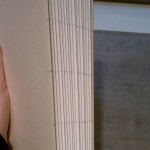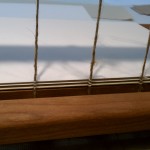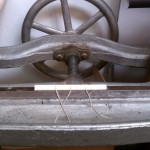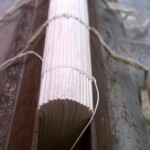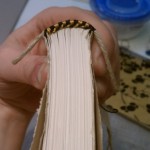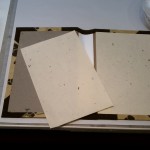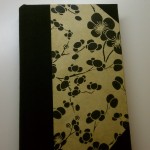Over the weekend, I went up to the San Francisco Center for the Book again and took Bookbinding 3. It was really fun! We did a bigger, more traditionally-bound book — just one rather than two — and it came out pretty well!
There are a number of things we did differently with this book than the ones I made in Bookbinding 2. For one thing, this one is a lot bigger — 18 signatures instead of 10. For another, we learned to handle the greatly increased swell (the increase in thickness at the spine of the book you get from the fold and from the thread used to sew the signatures together) with a much more curved spine. You can see in the photos below just how curved it turned out! The process requires using a piece of equipment called a job press — you basically put the book in once it’s a little rounded and crank it tight so that the swell is concentrated all at the end rather than making the whole book sort of wedge-shaped. It gives the book shoulders, where the curve is wider than the rest of the text sheets (almost like a mushroom shape, if you look down at it from the top). The cover boards sit in against the shoulders, so ideally the covers and pages are all flat, while the spine curves out on the edge.
We also learned to sew our own endbands, a process some of my classmates hated but which I really liked. It’s a bit tricky, but the product is so awesome that I don’t mind. I am planning on doing sewn endbands for all my books from now on!
We also used wheat paste for some steps instead of using the synthetic stuff we’ve used in the past. Every glue has advantages and disadvantages. Wheat paste takes longer to set, which can be a real advantage (you can move stuff around a bit after putting it together to get things perfectly lined up, for example) but is also a liability in a classroom setting, because it takes so much longer to dry. The biggest advantage to wheat paste in my eyes is that it’s totally reversible. You can melt it with some care and attention, enabling you to undo serious mistakes or redo a project once you know a better way. Once I get into conservation and restoration, I will probably be using wheat paste exclusively because a book precious enough to be restored will be worked on again in the future, for sure, and it’s good to make that future work a little easier when you can!
Wheat paste does have to be mixed fresh every time you want to use it (it molds very quickly when it’s wet, since it’s basically just flour and water) and you have to mix in calcium carbonate to make it pH-neutral, but it’s easy enough to do both those things that I don’t mind.
Finally, we added a lining to the inside of the cover so that there wouldn’t be a bump from the paper and bookcloth turn-in. This required some precision cutting, but wasn’t too hard, and I may add that to my own books in the future. The result is really nice.
So, here’s a look at the book!

